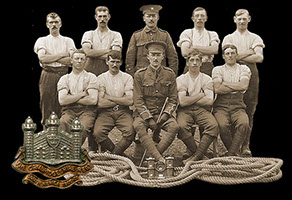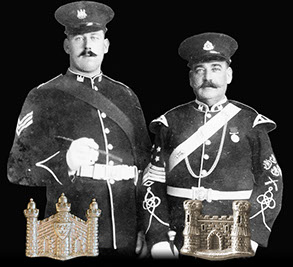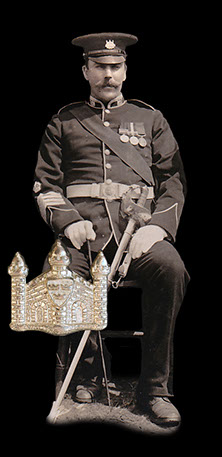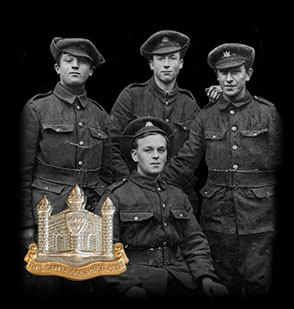
The Cambs
at War
Who Were
The Cambs
1/1st Btn 1914-1919
1914 - 1/1st Overview
1915 - 1/1st Overview
1915 - St Eloi
1915 - Fosse Wood
1916 - 1/1st Overview
1916 - The Schwaben
1916 - St Pierre Divion
1917 - 1/1st Overview
1917 - St Julien
Insignia, Medals & Books
Remembering The Cambs
Biographies
About Us &
This Site
The Men - Pre-War
The Officers
The Officers that made up the Cambs were volunteers from all across the county and from a wide range of professional occupations and businesses. Farm owners, lawyers, accountants, dentists, booksellers, builders, college fellows, magistrates, and architects were just a few of the occupations represented. Many had well established family links with the earlier Volunteer Battalion and even back to the Rifle Volunteer Corps days.
Among some of the family businesses, such as William Saint's builders, the link with the Regiment extended to the owners son serving as an officer and many of their workers in the ranks. Although there was a clear divide between officers and other ranks, in many cases the men knew each other well, both in the Regiment and in civilian life.
The Other Ranks
Like their officers the other ranks came from all across the county and covered a broad cross section of the society. Each of the eight Companies (Coys) had its own unique mixture of men that represented the employment in that recruiting area.
The more rural Fenland Coys were primarily made up of agricultural labourers from the local farms. However they also included many men from the larger employers in the towns of the Fens such as the breweries in Ely, the timber yards in Wisbech, and the Great Eastern Railway Depots at March, Ely, and Wisbech. The numerous small shops and businesses across the Fen towns and villages also had many staff volunteer.
The Cambridge Coys, like their Fenland counterparts, covered nearly every aspect of local employment. The colleges, University and its many departments had many "Terriers" working for them. None more so than the University Press whose workers made up nearly all of D Coy. Across the city large firms such as Eaden Lilley, Robert Sayles, Cambridge Scientific Instrument Company, Hallack and Bond Grocers, Hakwins Bakers, Cambridge Gas Company, Ortona Motor Company, and Macintosh & Sons Hardware to name just a few had many men serving in the Cambs.
As many of the Cambridge based Coys also included the surrounding villages in their recruitment areas there were plenty of agricultural labourers in them too. However large rural businesses like Chivers at Histon were also well represented in the numbers.
When the change over from Volunteer Battalion to Territorial Force took place in 1908 many of the "old sweats" that had been serving in the VB for years signed up in the new TF. They remained at the core of the new Regiment when it was formed in 1909, many going on to become senior NCOs. Slowly this old breed of VBs was replaced by a new wave of recruits, especially after 1912 when the four years of service expired for the men who had transferred over from the VB.
After a successful recruiting week in early 1914 the Coys were at full strength having been bolstered by a wave of new recruits. Many of this new wave were very young and with no family links or ties to the TF, they were fuelled by a sense that things were going on in the world and war was becoming ever more likely. This surge in recruiting was a hint to what was to come in August 1914 and the mass patriotic rush to sign up once war was declared.
The standard minimum age for enlistment in the TF was 17 although the Cambs like most other regiments had several bugler and drummer boys below this age. New recruits underwent a physical and were subject to the same standards as those enlisting in the Regular Army. Men enlisted for a period of four years, after that they could then leave or sign on again.
The men were expected to attend weekly training usually during a weeknight, they also had an annual summer camp usually in July. There were also numerous other events, competitions and specific training lessons at the weekends. Like the VB before it shooting made up a large part of the TF training and inter company competitions were commonplace and highly coveted.
The Cambs TF offered the counties men an adventure and a small escape from everyday life. It offered a bond and comradeship that went beyond those formed at work or social clubs. While some sections of society viewed the "Territorials" as something of a joke and "toy soldiers" there was a real sense of pride amongst the men of the Cambs. They soon became a tightly knitted family and a real esprit de corps was born.
The Permanent Staff
Whilst volunteers of the TF were part time and not professional soldiers, the Cambs like all TF regiments, needed a permanent staff of senior NCOs to act as instructors. As the Cambridgeshire Regiment had no regular Battalion to draw these men from they were supplied by the Suffolk Regiment. These instructors were each attached to a specific Coy and played a crucial part in the efficiency and running of the unit.
The Men - War Time
The Officers
With the outbreak of war and the influx of new recruits more officers were needed quickly. The Cambs were lucky as it was closely linked with the University's Officer Training Corps, a bond that went back to the Rifle Volunteer Corps days. Numerous new officers joined the Regiment from this source in the early months of the war.
As the war progressed and casualties amongst men and officers increased the Army was constantly looking for men with "leadership qualities" who would make good officers. This made it quite common for selected other ranks to be interviewed and following a screening process to undergo training to become commissioned officers. Many of the officers who joined the Cambs from late 1915 onward had spent time in the ranks of other regiments often having already served overseas.
Officers also joined the Cambs from much further afield; in early 1916 a wave of South African officers joined the Regiment. Later in the war several Canadians also joined the Regiment. These South Africans and Canadians had mostly joined their local infantry and cavalry units before being recognised as potential officers and sent to the UK for training. Many of them went on to serve with great distinction and several were decorated for their bravery.
The Other Ranks
Immediately after the declaration of war recruiting stations all across the county were swarmed with men eager to join up. Many wanted to enlist in their local unit and join their brothers, relatives, friends or co-workers who had joined the TF in previous years. Men joined up from every corner of the county and all walks of life. Numerous university students and men who would normally be considered "officer material" enlisted in the ranks not wanting to spend time training to be an officer and end up missing out on their chance to do their bit.
Volunteers from the towns and villages of the county kept the ranks of the Cambs supplied with new recruits. When enlisting a volunteer could put down which regiment he would like to join; therefore it is not too unusual to find early war volunteers from outside the county ending up in the Cambs especially if there is still a family link.
After the outbreak of war and through to early 1916 Regimental recruiting parties were formed. These normally consisted of several officers, senior NCO's, the band and a section of smart new recruits. They travelled around the county during several big recruiting drives visiting villages and towns as they went.
After the 1/1st Battalion went to France in February 1915 it was supplied with replacements via drafts of men from the Reserve Battalions in the UK. These drafts would often consist of men with the specific trades needed to replace the casualties and were often men who had been recovering from being wounded in action. While this process works well on paper these drafts would sometimes find themselves diverted to another unit in more pressing need of reinforcements. This meant that as the war went on men who had volunteered in the Cambs and served in the UK with them would often find themselves being transferred to a totally different regiment on arrival overseas. This also worked the other way round and meant that men joined the Cambs in France from other infantry regiments. This really became commonplace after the mass losses of the summer of 1916. A detailed study of the Cambs replacement drafts can be found by clicking here.
In March 1916 the British Government introduced conscription for the first time. It meant that men aged between 18 and 41 could now be called up for compulsory service in the Army. Initially it did not apply to married men but this was changed in May 1916. Men could still volunteer before receiving their call up. Local Military Service Tribunals were set up in order to assess whether a job or role in a company was to be considered a reserved occupation. By late summer 1916 drafts containing both conscripts and volunteers began arriving with the 1/1st Cambs in France.
The issues with the reinforcement drafts and the introduction of conscription did lead to a dilution of the county link in the 1/1 Cambs. This was increased further after the near crippling losses sustained by the British Expeditionary Force in March 1918 during the German Spring Offensive. Battalions were so battered halting the German advance that the replacement system was unable to cope. The solution was the merging of various battalions in an attempt to form one that was nearly at full strength. On the 19th May 1918 the 1/1st Cambs absorbed around 400 men from the 7th Battalion, Suffolk Regiment (the 7th Suffolk already having absorbed parts of the 8th Battalion, Suffolk Regiment in February 1918). A more detailed look at how the geographical composition of the Battalion changed during the course of the War can be found by clicking here.
Despite the dilution with replacement the Cambridgeshire Regiment kept its distinct identity and the bond with the county was always present and encouraged. There are numerous cases of men who were still serving with the 1/1st by November 1918 who had enlisted in the pre-war battalion, many having been wounded numerous times only to return again and again.
Fig A - Battalion Strength Figures.
1908 - 345 Transfer from 3rd Cambs
VB.
1909 - 19 Officers, 852 Other Ranks.
1910 - 21 Officers, 872 Other Ranks.
1911 - 20 Officers, 777 Other Ranks.
1912 - Currently Unknown
1913 - 19 Officer, 663 Other Ranks.
1914 - After recruiting week in January
reaches full strength for a TF Bn
of approx 1021.

Cambs 1914 camp Tug of War team winners.
For a guide to identifying and understanding the First World War era medals awarded to the men of the Cambs please click the link below.
Guide to the Great War Medals of the Cambridgeshire Regiment
Click the link below for a detailed study of Cambs service numbers and how to work out enlistment dates from them.

Sgt Pull and his father.

Cambs permanent staff Sergeant Major.

Four Cambs men in France in late 1915.
In 1931 the Cambridgeshire Regiment Old Comrades Association was officially created. A history of the OCA can be found here.
Fig B - Details of Coy Strength for 3-10-13.
A Coy - 2 Officers, 65 Other Ranks
- 52 Needed.
B Coy - 2 Officers, 87 Other Ranks
- 30 Needed.
C Coy - 2 Officers, 78 Other Ranks
- 39 Needed.
D Coy - 2 Officers, 101 Other Ranks
- 16 Needed.
E Coy - 2 Officers, 100 Other Ranks
- 17 Needed.
F Coy - 3 Officers, 92 Other Ranks
- 24 Needed.
G Coy - 1 Officer, 38 Other Ranks
- 80 Needed.
H Coy - 1 Officer, 95 Other Ranks
- 23 Needed.

This site went live on the 14th February 2015 to mark 100 years since the 1/1st Cambs went off to war.
WE WILL REMEMBER THEM
Email us: cambsregt@gmail.com
Copyright 2015, 2016, 2017, 2018, 2019 by Felix Jackson. The information and images on this site should not be reproduced without prior permission.